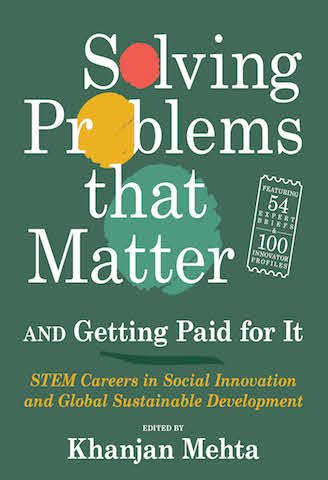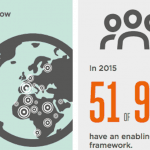What STEM Skillsets, Mindsets Bring to Sustainable Development
Editor’s note: This is the second post in a series exploring careers in social innovation and global sustainable development for science, technology, engineering and math (STEM) professionals. You can read the other posts here. The author discusses the issue in more depth in an ebook, available for free download here, and in his recent TEDx Talk.
Many people still believe that all scientists, engineers and programmers work in science, engineering and tech. Do all scientists pipette solutions in a clean white lab while all engineers take measurements on a construction site and programmers write apps in a cubicle? While many STEM professionals do fit these traditional roles, many more use their analytical skills to solve problems in other fields. According to the National Science Board, fewer than half the undergraduate STEM majors in the U.S. end up in STEM occupations. The rest go on to apply their skillsets, competencies and mindsets in the world of finance, education, health care and every other sphere of society.
STEM Skillsets
After a disaster, governments and nonprofits need engineers to rebuild roads, telecommunications systems and airports. To manage the 2014 Ebola outbreak in West Africa, we needed epidemiologists studying and controlling the outbreak and life scientists and biomedical engineers developing serological, immunological and drug therapies. Programmers can develop mobile phone apps to help farmers learn pest management strategies, and they need agricultural scientists to do it. In fact, nearly every STEM career can provide great value to sustainable development, but a STEM education offers much more than those specific skillsets.
STEM Mindsets
Your mindset defines how you see the world, how you think, how you react, how you take action and how you get the job done. Your mindset could be driven by a curiosity and desire to learn every detail before making a decision, it could be founded in a radical empathy for every stakeholder, or it might center on a deep desire for your work to have broad societal impact. STEM-educated professionals bring five mindsets to the sustainable development arena: problem solving, systems thinking, a quantitative approach, a data-driven approach and an evidence-based approach.
- Problem-Solving
STEM problem-solving involves structured scientific inquiry to identify a problem and then to work with relevant stakeholders on developing solutions. A problem-solving mindset embraces the rigors of the scientific method and logical flow of mathematical proofs as well as the iterative creativity of the engineering design process and the agile adaptability of software development. A STEM education in any field helps professionals focus on objectivity to solve problems and improve situations. STEM thinkers learn to unravel specific problems, analyze them from different angles, brainstorm many potential solutions, multi-dimensionally evaluate the best path forward and implement promising routes in a highly iterative manner. Applying this process throughout one’s STEM education develops it into a mindset that is incredibly useful for complex sustainable development challenges.
- Systems Thinking
A systems thinking mindset involves understanding the entire ecosystem in which you are working and how each part affects the others. STEM professionals are extensively trained in this approach, whether as civil engineering students working on urban buildings or neurobiologists studying mammalian brains. The global sustainable development arena is similarly complicated, formed around a tangle of societal grand challenges addressed by countless approaches, stakeholders and organizations. Change-makers must deeply understand the system and the stakeholders they seek to empower. Potential solutions must be harmonized with the system to account for contextual factors, from infrastructure limitations to current alternatives to sociocultural norms. This is a colossal task, but one STEM professionals are trained to understand and undertake after a deep background in system analysis.

Steve Downs
For example, Steve Downs, (left) an electrical engineer by training, seeks to improve health across the U.S. as the chief technology and information officer of the Robert Wood Johnson Foundation (RWJF). When the foundation took on the challenge to lower smoking rates, it focused on system-wide methods, including advocating for policies such as clean indoor air laws and higher taxes on cigarettes. In the 1990s and 2000s, it invested over $500 million and partnered with advocates and researchers from national and local health organizations, faith-based groups, businesses and the government to collaborate. They knew that just providing education or medication would not solve the systemic issue: A systems approach leverages interconnections between actors, factors and sectors to create supportive physical-social environments and services. Thanks to their systems approach, an independent evaluation found that RWJF and its collaborators brought smoking rates among adults down from 25.5 percent in 1993 to 20.6 percent in 2009 and rates among high school students down from 36 percent in 1997 to 19.5 percent in 2009. In addition, it estimated that 60,000 smoking-related deaths were avoided thanks to smoke-free indoor air policies and higher state and federal excise taxes during the two decades of their work. A systems thinking mindset enables STEM professionals to design and integrate long-term sustainable and scalable solutions.
- Quantitative Mindset
STEM professionals have always been recognized for their quantitative mindset – i.e. using mathematical techniques to understand and investigate problems. The sustainable development sphere has now embraced this approach, particularly in assessing whether solutions are achieving results. With so many societal challenges to address, many organizations have realized they need measurable results to validate their solutions and methods. For instance, many U.N. and government pronouncements from before 2000 were filed away and forgotten because they lacked a road map for measuring progress – but then we got the Millennium Development Goals. The MDGs set 2015 as a deadline for making specific quantitative improvements across a set of crucial areas, leading to great improvements. Bill Gates observed this quantitative need early on, which is why all Bill and Melinda Gates Foundation funds require clear measures and targets to drive progress for each goal. Gates, like all STEM thinkers, knows that you can only improve what you measure.

Srik Gopal
At Foundation Strategy Group (FSG), Srik Gopal (left) employs a quantitative mindset when he consults with organizations to implement the firm’s systematic evaluation programs. For example, Gopal and his team were brought in to help create “100Kin10,” a shared set of measures for organizations that are trying to train more STEM teachers. With so many organizations involved, FSG’s quantitative mindset helped everyone continue measuring and driving future efforts toward a common goal.
- Data-Driven Approach
Building upon the quantitative mindset, a data-driven mindset entails rigorously collecting and analyzing data to find trends and actionable insights. Today, more data is collected every minute than has been collected in most of human history. Within this trove of information are countless non-obvious causal relationships that can inform everything from health care to education to energy. For example, food shortages can be predicted from mining datasets of past market prices, droughts, migrations, regional production and seasonal variations – all variables identified through a deep understanding of interdependent systems.

Nigam Shah
Nigam Shah, (left) as an expert in biomedical informatics, employs a data-driven mindset to help doctors decide the best medical treatment. Shah and his team founded a company, Kyron, to create a search engine for doctors. The engine aggregates electronic health records to provide health professionals with the insights of hundreds of other doctors right from their point of care. Nigam’s work has shown that this medical record database can be used to monitor adverse drug events, learn drug-drug interactions, identify off-label drug usage, generate practice-based evidence for difficult-to-test hypotheses, and identify new medical insights. There are many more of these data relationships throughout the sustainable development field just waiting for STEM thinkers to analyze.
- Evidence-Based Approach
Abdul Latif Jameel Poverty Action Lab (J-PAL) explains that an evidence-driven mindset involves the iterative cycle of informing your strategy on available evidence, performing additional rigorous evaluations and using those results to improve, scale-up and institutionalize change. STEM professionals are trained extensively in this process through the scientific method and/or engineering design cycle. Sustainable development organizations can use that expertise to run objective evidence-based studies that investigate how effectively resources are used, accountability measures and solution impacts. For instance, randomized controlled trials (RCTs) objectively compare an organization’s implemented solution with what would have happened otherwise by randomly assigning subjects to treatment or control groups.
Skillset + Mindset

Doug Melton
Doug Melton (left) from the KEEN Program at the Kern Family Foundation is championing the development of an entrepreneurial mindset in engineers. He believes that an effective mindset works in tandem with a skillset. Consider a police officer who has developed a variety of law enforcement skills: weapons handling, defensive driving and authoritative communication. Her actions could still vary widely depending on whether she enters a situation with or without a mindset for fairness, civil safety and rule of law. This is just as true in STEM professions. Take, for example, a civil engineer designing a new bridge in India. He has the skillset to build it, but his mindset dictates how well he accommodates pedestrians and bicycles, how he works with his team to ensure that no compromises are made during the construction process, and how he explores and understands climate change impacts to ensure long-term utility and safety. Ultimately, his ability to lead the construction of the perfect bridge is a result of combining his mindset and skillset.
As important as these technical skillsets and rigorous mindsets are, they must also be strengthened with liberal arts competencies. Across the board, the sustainable development professionals I interviewed emphasized the importance of empathy, language skills, communication, contextual understanding, ethical decision-making, resilience and adaptability, and teamwork.
Image credit: r. nial bradshaw via Flickr
Khanjan Mehta is the Founding Director of the Humanitarian Engineering and Social Entrepreneurship Program at Penn State.
- Categories
- Agriculture, Environment, Technology
- Tags
- research



